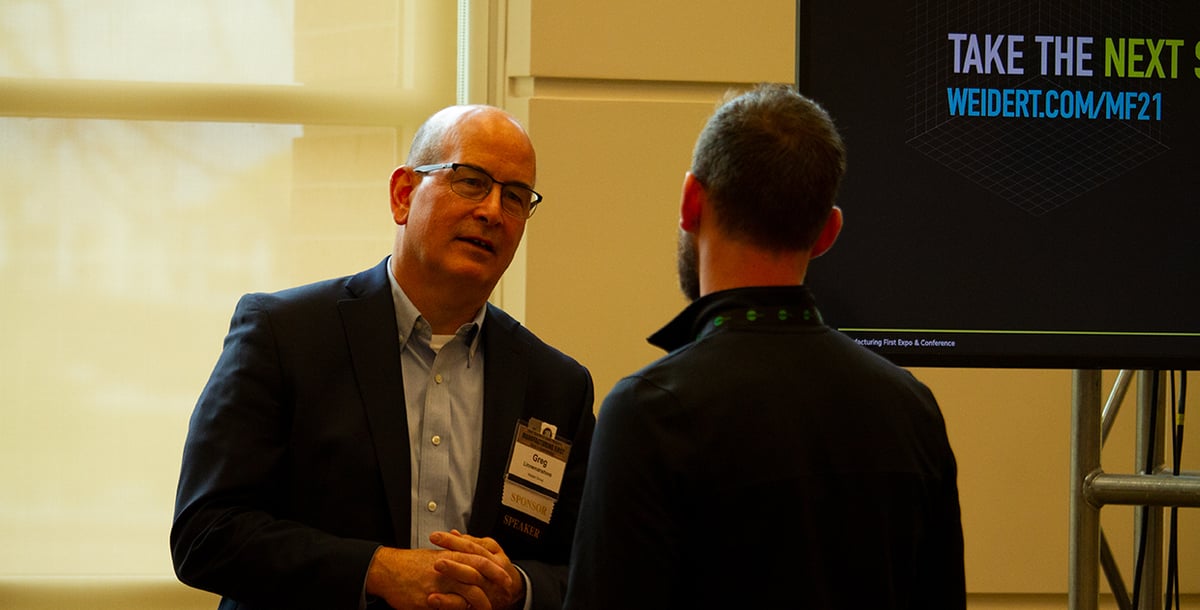


The Weidert Group team was among the many thrilled participants of Manufacturing First Expo & Conference 2021. The conference returned to in-person exhibitors, breakout sessions, and professional networking on October 27, with Weidert Group as a Gold-level sponsor for the fifth year in a row.
This year’s agenda featured a lineup of presenters focused on emerging opportunities and manufacturing industry trends, innovations, risks, and challenges that suggest some hard-learned lessons delivered by a (yet ongoing) global pandemic.
The adversity of the past 20 months has taught us that the capability to reimagine will serve us for the rest of our careers.
Businesses that overcome the challenges ahead will have proven their ability to create new visions within these key areas of operations:
Here are our biggest takeaways from Manufacturing First 2021, and how we see the lessons inspiring clients to clarify their business growth opportunities within this new landscape.
Dr. Rigsby’s inspirational keynote, “Soaring to New Heights,” focused on the personal side of leadership and what it takes to be “the kind of leader Grandma would hire.” He cited examples from his best-selling book, Lessons From a Third Grade Dropout.
Dr. Rigsby boiled it down to a few key lessons:
Dr. Rigsby reminded his audience that “nothing prepares you for greatness like uncertainty.” Challenges like the pandemic — and its ripple effects on manufacturing and the economy — create opportunities to look within ourselves, add new skills, and reimagine what we can become.
Multiple conference sessions focused on addressing talent attraction and retention to meet the demand for labor. It’s become clear that it takes much more than pay and benefits to attract and retain high-quality employees.
Emma McTague, Senior VP and Chief of Human Resources at Oshkosh Corporation, opened the day with a “TED Talk” style presentation — and a few sobering statistics. She said a 62% U.S. labor force participation rate and increasing rates of retirement are driving Oshkosh to re-skill some existing workers while finding more effective ways to attract new talent.
Multiple breakout sessions also offered workforce recruiting ideas that call for new thinking and greater flexibility, including:
Manufacturing recruiting is just the first part of the issue; preventing employee churn is the second. Retaining talent and reducing turnover requires manufacturers to take a hard look at their company cultures. It’s important for every worker to experience meaningful work and understand their role in contributing to making the world a better place.
It’s equally important to provide all workers with on-the-job growth. Create training programs with reskilling and upskilling opportunities that lead to advancement and inject new meaning into daily tasks. Assigning mentors or using a buddy system for new hires helps build a sense of shared community.
Managing prospective employee expectations is a piece of the puzzle, too. Tools like virtual tours, testimonial videos, and other targeted communications can help ensure the right people are in the right roles from the start, to improve longevity in new hires.
Risk mitigation strategies got a serious second (and third) look as the pandemic caused worldwide disruptions that continue to ripple through supply chains. In a panel discussion featuring Steve Ford of Lapham Hickey Steel, Sachin Shivaram of Wisconsin Aluminum Foundry, and Dane Dorn of CMD Corporation, these influential trends were cited as examples of impending change and the need to reimagine supply chains:
Data and artificial intelligence (AI) can improve forecasting and material purchasing, and that’s important because raw material and component backlogs are requiring manufacturers to anticipate demand up to a year from now. But effective AI demands data, and that means communicating more than ever with suppliers and customers, to understand both demand and supply needs.
The new supply chain environment also demands that manufacturers pay close attention to contract language. Suppliers are hyper-aware of the threat of their customers ordering extra and canceling later, so they’re also forced to hedge.
Product and service offerings may have entirely new potential in an altered landscape. Some manufacturing companies have been forced to bring production of critical components in-house, or look to reshoring and local solutions. That means incorporating a culture of responsiveness and agility within manufacturing, and looking at tools, equipment, and capacity with fresh eyes.
It can also mean identifying new demands for existing products and focusing marketing and communication campaign efforts on promoting products and services within new contexts. Reimagining products and services can uncover entirely new markets and uses, and can position manufacturers well for the next round of changes that lie ahead.
Manufacturers and industrial service providers that are going to continue to succeed will be those who most effectively harness reimagination to move forward. It’s already clear that not all businesses have uncovered the ways they can thrive in a transformed industrial manufacturing landscape. The pandemic effectively accelerated changes that were already underway while piling on added layers of complexity.
Marketing and sales are areas that were particularly affected by pandemic lockdowns, the migration of business online, and changes to labor participation. Purchasing decision-makers hold sales reps at arms’ length throughout their research and information-gathering efforts. It pays to make sure a solid sales enablement plan is in place, and that inbound marketing content is truly helpful to prospects.
Missed Greg’s session at Manufacturing First? Grab a copy of his slides and a free guide to Inbound Sales here.
It can be overwhelming to take on all this reimagination without guidance and structure, so we’ve gathered some of our best content and tools into a single resource, Inbound Marketing for Industrials. You’ll find a complete introduction to the inbound growth methodology, steps for establishing your own inbound program, and effective ways to optimize the strategies to meet your needs. You can even download a PDF version to keep on hand as a go-to resource. Just click below to check it out.
Topics: Manufacturing, Weidert Group Events
